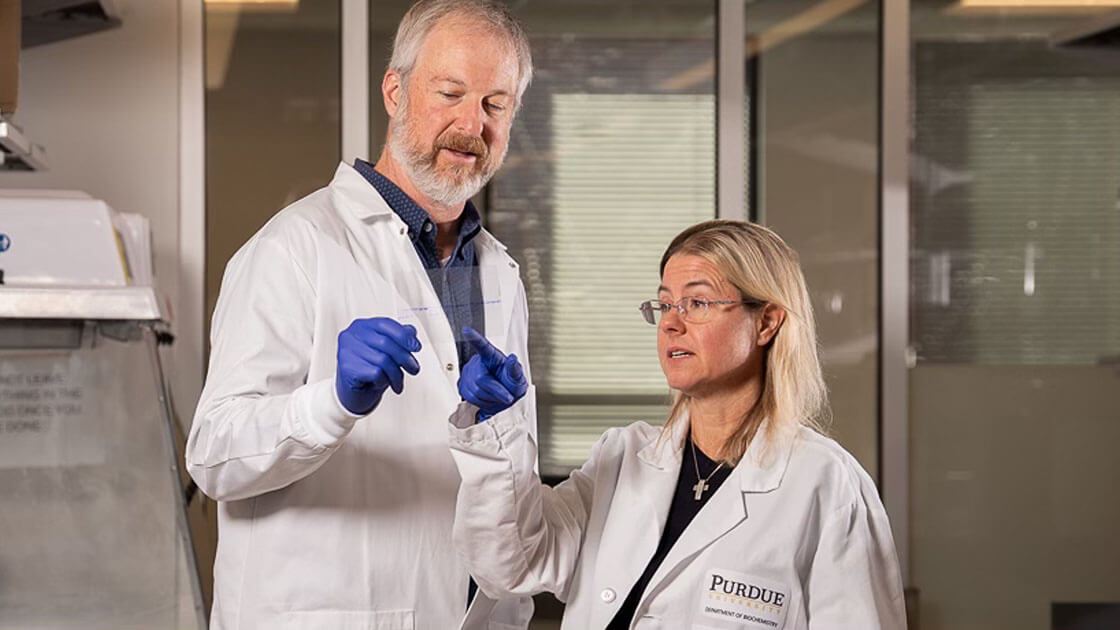PVM Scholar is co-principal investigator on study
Purdue University scientists led by co-principal investigators in the Colleges of Agriculture and Veterinary Medicine have identified the Supinoxin small-molecule drug as a possible new therapy for small-cell lung cancer (SCLC).
“Some cancer types are incredibly difficult to treat, one of them being small-cell lung cancer,” said Elizabeth Tran, professor of biochemistry in the College of Agriculture. Usually associated with smokers, SCLC accounts for only 15% of all lung cancer types. Despite the low percentage, SCLC causes about 250,000 deaths worldwide annually.
“The really sad thing about it, and why we wanted to look at small-cell lung cancer, is that the average survival for a patient after diagnosis is around 10 months,” Tran said. “Right now, the effective chemotherapies are practically nonexistent.”
Purdue Institute for Cancer Research members Tran and co-principal investigator Bennett Elzey, research associate professor of comparative pathobiology in the College of Veterinary Medicine, have published their results in the journal iScience. The team suggests that Supinoxin will more effectively treat tumors when combined with another therapeutic. The latest experiments probed the effects of Supinoxin on DDX5 protein activity in cancerous human cell lines and in an animal model.
“The hope is that while the Supinoxin keeps tumors small and keeps them from growing, we can hit the tumors with something else that will kill them,” Elzey said.
A team of researchers announced their synthesis of Supinoxin, also called RX5902, in 2010. Commercially available, Supinoxin has shown effectiveness in treating highly aggressive triple-negative breast cancer.
Supinoxin blocks SCLC progression through the DDX5 protein. Researchers in Tran’s lab published results in 2020 showing that DDX5 helps support the cancer’s malignant growth. DDX5 belongs to a family of RNA helicases, enzymes that unwind RNA molecules to begin a process allowing for various cellular functions to occur.
The 2020 paper reported that blocking DDX5 activity in SCLC cells via genetic manipulation reduces oxidative phosphorylation. This compromises the mitochondria — the powerhouse of the cells — and they die.
“The mitochondria go bad, and you have defective oxidative phosphorylation as well as defective cellular respiration,” said co-author Subhadeep Das, a postdoctoral scientist in biochemistry.
The researchers found that Supinoxin acts on DDX5 to reduce oxidative phosphorylation, Das noted. Oxidative phosphorylation is an essential part of the cellular respiration process that fuels virtually all biological and physical activity. Cellular respiration generates adenosine triphosphate (ATP), the energy-carrying molecule that fuels cellular activity.
Research dating back a century led scientists to believe that cancer cells depend solely on glycolysis to generate ATP. In the last decade, however, new evidence has emerged that some cancer cells draw upon oxidative phosphorylation to generate ATP.
“It is still commonly thought that cancer cells rely on energy only by using the glycolysis pathway, but that turns out not to be true for all cancer types,” Tran explained. In cancer cells that depend predominantly on glycolysis, sugar is taken in and burned for energy without the end product of that reaction going through oxidative phosphorylation to obtain ATP in large amounts.
“Some types of cancer do use oxidative phosphorylation, and if they don’t have any energy, they can’t grow,” Tran said. “There is still an open question because we don’t know precisely how DDX5 is playing a role in that process of generating ATP.”
Tran, an RNA biologist, joined the Purdue faculty in 2009. Her early work at Purdue focused on using baker’s yeast as a model system for understanding RNA biology.
“We did a lot of work on an RNA helicase in that model system,” Tran said. “We found out what it does in a cell, but we also knew that its human counterpart had connections to cancer, and we didn’t understand why.” That led Tran to begin researching SCLC in 2018.
“We wanted not only to understand what that RNA helicase counterpart does in human cells, but if it is connected to promoting cancer growth and metastasis, can we stop it? Is there some way to identify a new chemotherapeutic that could be used to treat cancer types?”
Tran touts the potential for studying RNA helicase inhibitors like Supinoxin not only as cancer treatments but also as lab tools to learn how helicases work and what they do. DDX5 belongs to a family consisting of 40 RNA helicases.
A better understanding of RNA biology could lead to new targets for human disease treatment, Tran noted. Chemotherapies often target the cycle that cells undergo to grow and divide.
“RNA in general hasn’t been on people’s radar. It has precedence, I just don’t think it’s generally acknowledged,” she said. Elzey agreed that looking further into RNA biology could yield new clinical cancer treatments targeting the DDX family of proteins. “I’m looking forward to expanding our model, refining it and answering more difficult questions with it,” he said.
This research was funded by the Purdue Institute for Cancer Research and the National Institutes of Health.

